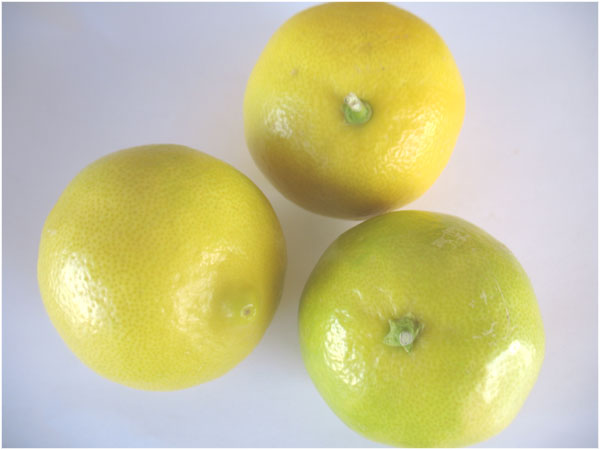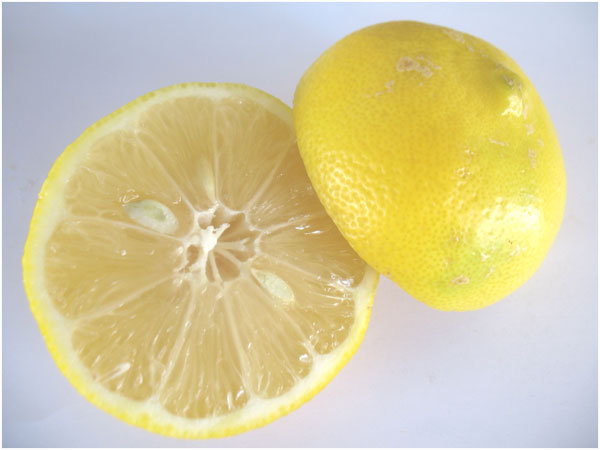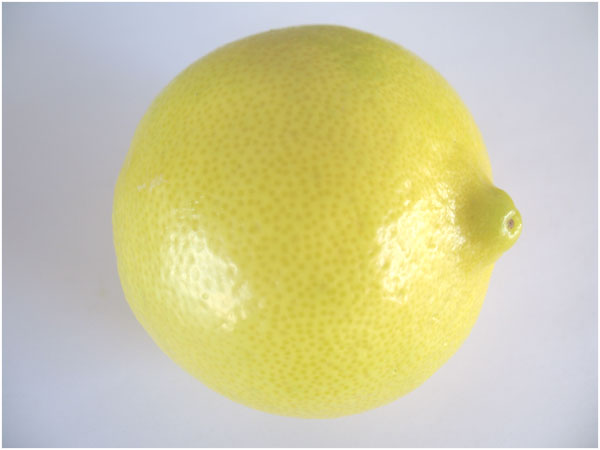| Author |
Message |
MeyerLemon
Citruholic

Joined: 25 Jun 2007
Posts: 273
Location: Adana/Turkey Zone9
|
| Posted: Fri 30 Nov, 2007 3:53 pm |
|
Hi,
We have 2 trees of this citrus cultivar, we call it sweet lemon but I think it is a kind of a lime.It smells really different from general citrus and it tastes really sweet, like eating sugar.
Can you name it with the help of these photographs;



Thanks a lot, |
|
| Back to top |
|
 |
Junglekeeper
Citruholic


Joined: 19 Nov 2005
Posts: 290
Location: Vancouver BC Canada
|
| Posted: Fri 30 Nov, 2007 3:57 pm |
|
It looks like the sweet lemon I recently taste-tested. The seeds were creamy white like yours.
_________________
Indoor Grower |
|
| Back to top |
|
 |
JoeReal
Site Admin


Joined: 16 Nov 2005
Posts: 4726
Location: Davis, California
|
| Posted: Fri 30 Nov, 2007 4:58 pm |
|
I wonder how it could taste sweet, what is the trick. My friend's tree, all of the sweet lime and sweet lemon fruits are bland, very very bland. Perhaps masticating on Miracle fruit should do the trick. So do you have secret as to why yours is sweet? |
|
| Back to top |
|
 |
Millet
Citruholic


Joined: 13 Nov 2005
Posts: 6657
Location: Colorado
|
| Posted: Fri 30 Nov, 2007 6:46 pm |
|
Looks like a Palestine Sweet Lemon. The Palestine Lemon is very juicy with a sweet and insipid flavor. Usually has 10 membranes. |
|
| Back to top |
|
 |
MeyerLemon
Citruholic

Joined: 25 Jun 2007
Posts: 273
Location: Adana/Turkey Zone9
|
| Posted: Fri 30 Nov, 2007 8:25 pm |
|
Well, I have no idea what is the trick JoeReal 
This lemon cultivar is around for many years in my city, many farmers have it.But it is not much known in other cities.
Some people like the sweet taste very much, some people don't even like it.
Thanks a lot Millet, I will check Palestine lemon on web for more info. |
|
| Back to top |
|
 |
jjp
Citruholic

Joined: 27 Apr 2006
Posts: 55
Location: Corsica
|
| Posted: Fri 30 Nov, 2007 8:48 pm |
|
|
|
| Back to top |
|
 |
jjp
Citruholic

Joined: 27 Apr 2006
Posts: 55
Location: Corsica
|
|
| Back to top |
|
 |
Laaz
Site Owner


Joined: 12 Nov 2005
Posts: 5648
Location: Dorchester County, South Carolina
|
| Posted: Fri 30 Nov, 2007 9:16 pm |
|
_________________
Wal-Mart a great place to buy cheap plastic crap ! http://walmartwatch.com/ ...
 |
|
| Back to top |
|
 |
JoeReal
Site Admin


Joined: 16 Nov 2005
Posts: 4726
Location: Davis, California
|
| Posted: Fri 30 Nov, 2007 11:52 pm |
|
So what this really is, a lemon or a lime?
Can someone settle the issue once and for all? |
|
| Back to top |
|
 |
Laaz
Site Owner


Joined: 12 Nov 2005
Posts: 5648
Location: Dorchester County, South Carolina
|
| Posted: Sat 01 Dec, 2007 12:29 am |
|
_________________
Wal-Mart a great place to buy cheap plastic crap ! http://walmartwatch.com/ ...
 |
|
| Back to top |
|
 |
MeyerLemon
Citruholic

Joined: 25 Jun 2007
Posts: 273
Location: Adana/Turkey Zone9
|
| Posted: Sat 01 Dec, 2007 8:14 am |
|
More info on this page;
| Quote: | Fruit medium in size, subglobose to oblong or short-elliptic, sometimes faintly ribbed; base evenly rounded; apex commonly rounded; areolar area often protruded into a low, flat nipple surrounded by a shallow circular furrow. Seeds few, highly polyembryonic; chalazal spot light tan (almost blond); cotyledons faint green. Rind thin to very thin; surface smooth to very smooth with prominent oil glands flush with surface; tightly adherent; color greenish to orange yellow at maturity. Aroma of rind oil distinctive. Segments about 10; axis medium in size and semi-hollow at maturity. Flesh color straw-yellow; tender, very juicy; flavor insipid because of lack of acid, and with slightly bitter aftertaste. Single bloom and crop.
Tree distinctive in appearance, medium-large in size and of spreading but irregular growth habit, with thick, thorny branches; foliage medium-dense. Leaves pale green, medium in size, long-oval, blunt-pointed, and characteristically cupped or rolled, with petioles wing-margined rather than winged as in most limes. Flowers medium-large, pure white, and new shoot growth pure green.
The Indian sweet lime is the mitha nimbu (numerous modifications and other local names) of India, the limûn helou or succari of Egypt, and the Palestine sweet lime (to distinguish it from the Millsweet and Tunisian limettas, commonly called sweet limes).
In India, where this fruit has been grown longer than elsewhere, several forms are recognized that differ principally in fruit shape, presence or absence of the nipple, and in fruitfulness. In northeastern India, to which it is native, it has been established (Hodgson, Singh and Singh, 1963) that the soh synteng of Assam is the acid form of this fruit. It is similar in all respects except: (1) the fruit is highly acid; (2) at a limited and ephemoral [sic] stage pink coloration is present in the flower buds and new shoots; and (3) the color of the chalazal spot is pinkish-purple.
The Indian sweet lime and the Tahiti lime bear slight resemblances to the galgal or hill lemon of India and the Tunisian limetta. There are virtually no resemblances to the small-fruited acid lime.
In California, this sweet lime is remarkably affected by climatic influences. Desert-grown fruit differs so greatly in size, color, form, and rind texture from that produced in the cool, equable coastal region that the inexperienced observer would consider them to be different fruits.
The sweet lime is much esteemed in India, the Near East, Egypt, and Latin America and is considered to have special medicinal values in the prevention and treatment of fevers and liver complaints. Statistics are not available, but the sweet lime is grown commercially in northern India and Egypt and widely elsewhere as a garden plant. It is also a rootstock of considerable importance in parts of India and of major importance in Israel and Palestine.
The most unusual practice of horticultural interest in the culture of this fruit is the universal use of rooted-cutting trees in Egypt, whereas seedling trees are most commonly used elsewhere.
The Tunisian limetta has been classed as a sweet lime but in the opinion of the writer is more logically considered an acidless member of the limetta group (C. limetta). It resembles the Indian sweet lime only in flavor and the tendency to cupping of the leaves. The essential oil of the rind is altogether different in aroma and typical of the other limettas, as are all the other characters.
Columbia appears to be the best known named clonal selection of the sweet lime. |
|
|
| Back to top |
|
 |
Steve
Citruholic

Joined: 10 Sep 2007
Posts: 253
Location: Southern Germany
|
| Posted: Mon 10 Dec, 2007 6:25 pm |
|
| JoeReal wrote: | So what this really is, a lemon or a lime?
Can someone settle the issue once and for all? |
Joe, because of the rush for 'historical citrus' many acidless trees were named, just to give it a better sell.
So what we see here are fruits of Citrus limettioides, or Sweet Palestine Lime. So that's not a lemon, it's a own variety and reffering to Tanakas system of citrus botanical names system, also it's own species.
So it's not lemon, it's not lime, it's Palestine Sweet 
_________________
Eerh, hmm, uuuh, oooh, just guessing  |
|
| Back to top |
|
 |
JoeReal
Site Admin


Joined: 16 Nov 2005
Posts: 4726
Location: Davis, California
|
| Posted: Mon 10 Dec, 2007 6:31 pm |
|
Thanks to all who answered to try to resolve the issue. |
|
| Back to top |
|
 |
MeyerLemon
Citruholic

Joined: 25 Jun 2007
Posts: 273
Location: Adana/Turkey Zone9
|
| Posted: Tue 28 Oct, 2008 9:22 am |
|
Btw, last night while I was eating few of these Palestine Sweets, I noticed that I forgot to mention that this variety is more cold tolerant than any other lemon we have.
We have orchards in 2 different area of the city and there are average 4C difference between them.We have all lemons in the hot part and many trials to grow lemon in the cold part was unsuccesful.
But Palestine sweet trees are in the cold part and they are very healthy and never affected from cold.Last year we saw -8C in that part and the trees were fine. |
|
| Back to top |
|
 |
Matt N
Citruholic

Joined: 24 Mar 2007
Posts: 58
Location: Dallas, TX z8
|
| Posted: Tue 28 Oct, 2008 8:04 pm |
|
That is interesting. I have a 3' plant in a container that I have been growing, but it has not fruited yet. I have wondered how much cold the 'palestine' can take. I would like to plant it in ground when it grows larger. Does anyone know the cold hardiness limit of the 'palestine'?
thanks for the pics and info |
|
| Back to top |
|
 |



























